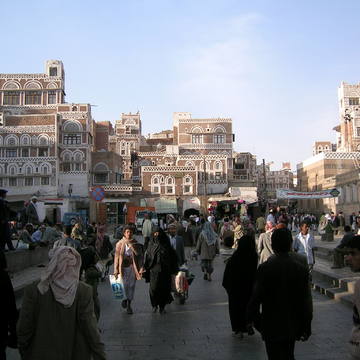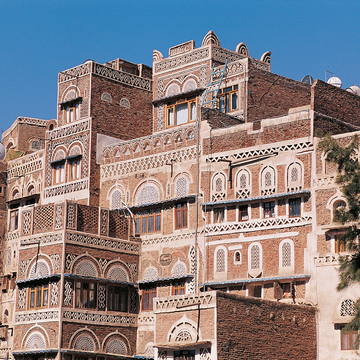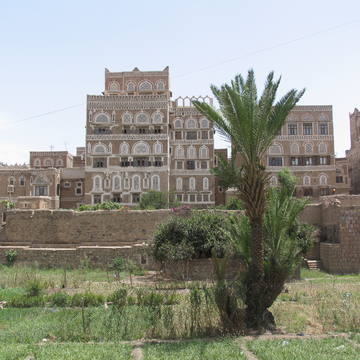Old City of Sana’a
Situated in a mountain valley at an altitude of 2,200 m, Sana’a has been inhabited for more than 2,500 years. In the 7th and 8th centuries the city became a major centre for the propagation of Islam. This religious and political heritage can be seen in the 103 mosques, 14 hammams and over 6,000 houses, all built before the 11th century. Sana’a’s many-storeyed tower-houses built of rammed earth (pisé) add to the beauty of the site.
Outstanding Universal Value
Brief synthesis
Situated in a mountain valley at an altitude of 2,200 m, the Old City of Sana’a is defined by an extraordinary density of rammed earth and burnt brick towers rising several stories above stone-built ground floors, strikingly decorated with geometric patterns of fired bricks and white gypsum. The ochre of the buildings blends into the bistre-colored earth of the nearby mountains. Within the city, minarets pierce the skyline and spacious green bustans (gardens) are scattered between the densely packed houses, mosques, bath buildings and caravanserais.
Inhabited for more than 2,500 years, the city was given official status in the second century BC when it was an outpost of the Yemenite kingdoms. By the first century AD it emerged as a centre of the inland trade route. The site of the cathedral and the martyrium constructed during the period of Abyssinian domination (525-75) bear witness to Christian influence whose apogee coincided with the reign of Justinian. The remains of the pre-Islamic period were largely destroyed as a result of profound changes in the city from the 7th century onwards when Sana’a became a major centre for the spread of the Islamic faith as demonstrated by the archaeological remains within the Great Mosque, said to have been constructed while the Prophet was still living. Successive reconstructions of Sana’a under Ottoman domination beginning in the 16th century respected the organization of space characteristic of the early centuries of Islam while changing the appearance of the city and expanding it with a second city to the west. The houses in the old city are of relatively recent construction and have a traditional structure.
As an outstanding example of a homogeneous architectural ensemble reflecting the spatial characteristics of the early years of Islam, the city in its landscape has an extraordinary artistic and pictorial quality. Its many-storied buildings represent an outstanding response to defensive needs in providing spacious living quarters for the maximum number of residents within defensible city walls. The buildings demonstrate exceptional craftsmanship in the use of local materials and techniques. The houses and public buildings of Sana’a, which have become vulnerable as a result of contemporary social changes, are an outstanding example of a traditional, Islamic human settlement.
Described by historians, geographers and scholars of the early Islamic and medieval eras, Sana’a is associated with the civilizations of the Bible and the Koran.
Criterion (iv):Within its partially preserved wall, it offers an outstanding example of a homogeneous architectural ensemble, which design and detail translate an organization of space characteristic of the early centuries of Islam which has been respected over time.
Criterion (v): The houses of Sana’a, which have become vulnerable as a result of contemporary social changes, are an outstanding example of an extraordinary masterpiece, traditional human settlement.
Criterion (vi): Sana’a is directly and tangibly associated with the history of the spread of Islam in the early years of the Hegira. The Great mosque of Sana’a, built in year 6 of Hegira, is known as the first mosque built outside Mecca and Medina.The Old City of Sana’a has contributed to and played a major role in Yemeni, Arab and Islamic World history through the contributions of historical Yemeni figures including Al Hassan B. Ahmed Al Hamdany, Ahamed Al Razy and Al Shawkany.
Integrity (2011)
A significant proportion of all the attributes that express the Outstanding Universal Value are within the property. However, in certain quarters of the city, acceleration of new development is eroding its character. The visual integrity of the property is threatened by an increase in new modern hotels and telecommunication towers in the surrounding landscape.
The disappearance of the traditional juridical system or the application of new and supplementary ones, the accelerated social and economical changes, the rapid urban development within and around the city and the disappearance of open space as the bustans are gradually built over, are creating various unbearable pressures on the city and its inhabitants.
Authenticity (2011)
The attributes that carry Outstanding Universal Value are the overall design of the city and its buildings with their decorated façades, traditional building materials, and the open spaces (bustans, maqashe and sarah’at ) considered as part of the city’s urban environment, together with the visual appearance of the city surrounded by mountains. The authenticity of these attributes is vulnerable to incorrect conservation practices and development. Associated intangible values relating to traditional socio-economic activities, including the very high percentage of home ownership, continue to be demonstrated.
Protection and management requirements (2011)
The protection of the Old City of Sana’a is ensured by the Antiquities Law of 1997 as well as the Building Law of 2002. Protection will be improved when the Historical Cities Preservation Law comes into force. The preparation of a Conservation Plan, and of an exhaustive inventory of buildings of the city and its surroundings have been completed. The General Organization for the Preservation of the Historic Cities of Yemen (GOPHCY) aims to develop the Conservation Plan in the next few years. It is also proposed to establish a Conservation Unit to involve all stakeholders, who will be encouraged to participate in the preparation of the city Management Plan process. GOPHCY, established in 1990, is an independent body set up to create an appropriate strategy for sustainable development. After the new Law enters into force, it will become the overall authority for management of the World Heritage property.
In its decision concerning inscription, the World Heritage Committee “recommended that an adequate buffer zone should be established around the old city.” This recommendation should be implemented in order to improve the protection of the property which also needs clearly defined boundaries.
In the long term, it is intended to adopt a clear strategy for sustainable preservation and development of the Old City and to reach a better control of the setting as well as ensuring the balance between commercial and residential activities.












